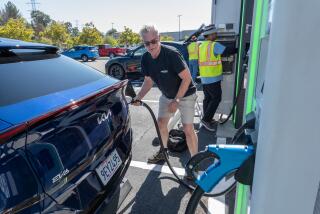Getting Off Gas
- Share via
It wasn’t that long ago that everything seemed so simple: pump gas into your car, get behind the wheel and go. But as the internal combustion engine slowly but surely yields ground to alternative energy sources, sorting out the various technologies has gotten a lot more complicated. Read on to discover more about the different types of clean engine technology currently available.
Hybrids
A hybrid vehicle uses at least two different power sources to operate. Hybrid electric vehicles — currently the most popular — combine an internal combustion engine with one or more electric motors, and offer significant fuel economy. The 2012 Toyota Prius C, for example, gets a combined 50 miles per gallon city/highway.
Often, advanced technologies are incorporated into hybrid vehicles to increase efficiency. Regenerative braking systems convert the energy used to slow the wheels into electricity that is stored in the car’s battery. Automatic start/shutoff systems turn off the engine when the vehicle is idling and restart it when the accelerator is pressed.
Examples: Honda Civic Hybrid, Infiniti M Hybrid, Toyota Prius, Chevy Volt
Electric Vehicles
Fully electric vehicles, called EVs, are propelled by one or more electric motors powered by rechargeable battery packs. Electric motors are quiet and smooth to drive, and can provide stronger acceleration and require less maintenance than internal combustion engines. They are highly energy efficient, converting 75% of the chemical energy stored in the batteries into power for the wheels (internal combustion engines convert just 20% of the energy stored in gasoline). EVs are also more environmentally friendly, emitting no tailpipe pollutants, though the power plant that produces the electricity may emit pollutants if it is coal-fired and not powered by nuclear, hydro, solar or wind.
EVs still have some significant battery challenges to overcome, which will ultimately determine their wide-scale acceptance and success. For instance, most EVs can only travel about 100 to 200 miles before needing to be recharged — a process that takes four to eight hours. Battery charging can be accomplished more quickly if a 240-volt charging unit is available. A quick charge to 80% capacity (in as little as 30 minutes) is possible with some models. The batteries are also large, heavy and expensive to replace.
Examples: Mitsubishi i, Smart Car Fortwo Electric Drive, Nissan Leaf, Fisker Karma, BMW ActiveE
Plug-ins
A “plug-in” is any vehicle that needs to be literally plugged in to a wall socket or charging station in order to recharge its batteries. These can be hybrids with electric propulsion like the Prius Plug-in or fully electric vehicles like the Nissan Leaf. All electric vehicles currently available in the U.S. and many hybrids fall into this category.
Ethanol
This alcohol-based fuel is created by fermenting and distilling sugar or starch products like grain, sugar cane, sugar beets or even lactose as well as “cellulosic biomass” like trees and grasses. Ethanol emits fewer greenhouse gases, reduces dependency on foreign oil and utilizes renewable resources.
Ethanol is normally mixed with gasoline in various combinations. E10 (“gasohol”) is a blend of 10% ethanol and 90% gasoline that can be used in all gasoline vehicles; E85 is 85% ethanol and 15% gasoline and can be used in purpose-built flexible fuel vehicles (FFVs) with no difference in car performance. But ethanol’s low energy content means it generates lower miles per gallon that gasoline — 3% to 5% less in the case of E10 and 25 to 30% less with E85. While the manufacture and use of ethanol vehicles is growing, it may be hard to find a place to fill up — the U.S. Department of Energy reports fewer than 100 stations selling E85 in California.
Examples: Chrysler 300 E85 FlexFuel, Ford Focus E85 FFV, Chevy Tahoe E86 FFV
Hydrogen and Hydrogen Fuel Cell
All hydrogen technologies work on the same principle as gasoline: A chemical reaction takes place and energy is released. In a hydrogen-powered engine, the energy from hydrogen combustion is converted into mechanical energy to power the wheels. But in fuel-cell vehicles, the chemical energy produced from the reaction of hydrogen and oxygen is converted into electrical energy.
Most fuel cells designed for vehicles produce less than 1.16 volts of electricity each, so multiple cells must be assembled into fuel cell stacks, which are expensive and space consuming. Fuel cell systems are less durable than internal combustion engines in some temperature and humidity ranges. Gas stations and the refineries that supply cannot be used for hydrogen distribution, so new infrastructure must be constructed.
Example: Honda FCX Clarity
Natural Gas
With fewer smog-producing pollutants and green house gas emissions than other fossil fuels, natural gas engines are one of the cleanest-burning internal combustion alternatives. Another advantage is a huge capacity for domestic fuel production rather than overseas. Compressed natural gas (CNG) and liquefied natural gas (LNG) are already used to fuel thousands of cars, trucks and buses. Some are dedicated natural gas vehicles (NGVs) while others are bi-fuel vehicles that can operate on gasoline or diesel as well as natural gas. Natural gas vehicles are not yet available on a large scale to consumers in the U.S., but conventional gasoline and diesel vehicles can be retrofitted for CNG.
Example: 2012 Honda Civic GX Natural Gas
Diesel and Biodiesel
Diesel fuel derived from vegetable oils, animal fats or recycled restaurant greases is called biodiesel. It’s nontoxic, biodegradable and renewable and produces fewer air pollutants than petroleum-based diesel during combustion. Biodiesel can be used in its pure form (B100) or blended with petroleum diesel. Common blends include B2 (2% biodiesel), B5 and B20. B2 and B5 can be used safely in most diesel engines. On the other hand, B100 is not suitable for low temperatures and can reduce engine durability.
Traditional diesel-powered vehicles, meanwhile, may be making a comeback — since they offer about 30% better fuel efficiency (and more torque) than their gas-only counterparts. Additionally, vibration-damping technologies have made them smoother and quieter than they were in the 1980s. Advances in engine technologies, ultra-low sulfur diesel fuel and improved exhaust treatment have made traditional diesel cleaner.
Examples: Volkswagen Beetle TDI, Audi A3 TDI, Chevy Silverado 3500HD
– Joe Yogerst
Custom Publishing Writer






